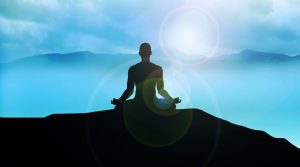The word Preksha means “profound awareness of the self”. In Jainism, the technique of Preksha Dhyaan or meditation was formulated by Acharya Mahapragya in the 20th century, based on the philosophy and practice of Lord Mahaveera. Lord Mahaveera attained enlightenment through Preksha dhyan.
Acharya Mahapragya developed Preksha Meditation as a special practice influenced by the tenets of the Jain Agamas, ancient scriptures, Yoga Science, Biology, Modern Physics, Naturopathy, Ayurveda, etc. He brought together Meditation, Yogasana, Pranayama and Mantra. The holistic approach of Preksha Meditation towards health is relevant in the present times for people practising meditation to combat physical, mental, emotional, and spiritual ailments that afflict them.
In Preksha, the ultimate objective is to attain enlightenment but for the ordinary individual, it makes everyday life more meaningful and gratifying. Preksha Dhyaan helps in purifying our physical body, our mental, emotional, and spiritual health. It helps us connect to our consciousness while improving our behaviour and attitudes. Preksha Dhyaan is instrumental in correcting the energy imbalance in our body to bring about holistic improvement.
There are several techniques associated with the correct practice of Preksha Dhyaan, like Kayotsarga (separation of the body from the consciousness), Antaryatra (the internal trip), Shvaas Preksha (perception of the breath), Chaitanya Kendra Preksha (perception of the psychic centre), Leshya Dhyaan (perception of colour), Anupreksha (contemplation) and Sharir Preksha, which can be utilized to correct the individual afflictions of practitioners under the guidance of a guru. Each of these are explained in brief as follows:
Kayotsarga – Literally, kaya ka utsarg, or realizing the independence of the consciousness from the body, Kayotsarga is used to relax the body and soul in entirety through autosuggestion. This technique is also used to transform the negative thoughts.
Antaryatra – Literally translated as Internal Trip, Antaryatra is a technique for the realization of one’s true self. In this the vital life force (Praan) is harnessed to cultivate moderation and self-restraint in order to prepare for deeper levels of meditation. It is also helpful in calming the mind and relieving anxiety.
Shwaas Preksha – Literally ‘perception of breathing’, Shwaas Preksha is used to control and regulate the speed and rhythm of breathing to normalize one’s health.
Chaitanya Kendra Preksha – This is the technique for activating the various Chaitanya Kendras or psychic centres present in our body through Preksha Meditation. The objective is to activate the particular energy centre to attain balance of flow of energy. It corrects the aura to positively transform thoughts, behaviour and actions.
Leshya Dhyaan – Perception of colours in Preksha Meditation is known as Leshya Dhyaan. In Leshya Dhyaan, the objective is to address the imbalance of energy (responsible for all disorders) by visualizing colours and attracting the energy associated with them through guided colour meditation.
Anupreksha – Literally translated as contemplation, Anupreksha is a technique to channel all the negative thoughts within us. Anupreksha transforms negative thoughts through meditation to align them in positive direction.
Sharir Preksha – Literally, perception of the body, Sharir Preksha entails the observation of the subtlest phenomena occurring in every cell of the physical body through the process of deep concentration to realize the true self. It helps to achieve




